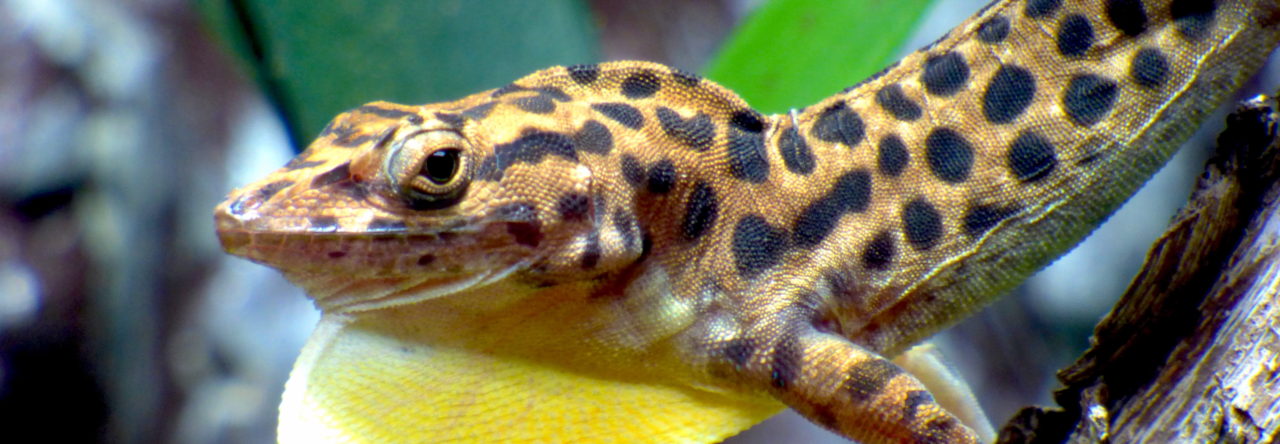Anole morphology holds an important place in the recent history of evolutionary biology. For example, comparisons of morphology, behavior, and ecology among Anolis species led E. E. Williams to conceptualize ecomorphology (discussed here). The repeated Caribbean anole radiations are also of great importance for studies of convergence, parallelism, and constraint (e.g., here and here). Surprisingly, however, the vast majority of anole research has focused on postcranial characters; comparatively few studies have surveyed variation in head shape and its functional and ecological significance. While strong correlations between relative limb length and microhabitat have been the subject of much research, one cannot overlook the fact that variation in head shape may also have important ecological and evolutionary significance for this genus.
 Even a brief visual survey of the MCZ skeletal collection reveals an array of variation in anole head shape: from the robust skull of A. cybotes to the slender skull of A. dolichocephalus to the ornate skulls of Chamaeleolis (Here is a real challenge: Can anyone name the species in the picture?). Harmon et al. (2005) used three-dimensional geometric morphometrics for 21 anole species and concluded that anole heads primarily vary in relative length and depth. To further investigate which skeletal elements contribute to this variation and how many times anoles have independently converged on similar head shapes Sanger et al. recently analyzed skull shape variation among males of 106 Caribbean species (yes, Sanger, that’s me).
Even a brief visual survey of the MCZ skeletal collection reveals an array of variation in anole head shape: from the robust skull of A. cybotes to the slender skull of A. dolichocephalus to the ornate skulls of Chamaeleolis (Here is a real challenge: Can anyone name the species in the picture?). Harmon et al. (2005) used three-dimensional geometric morphometrics for 21 anole species and concluded that anole heads primarily vary in relative length and depth. To further investigate which skeletal elements contribute to this variation and how many times anoles have independently converged on similar head shapes Sanger et al. recently analyzed skull shape variation among males of 106 Caribbean species (yes, Sanger, that’s me).
Similar to Harmon et al. our analysis also finds that anole heads primarily vary in length, specifically due to variation in the length of their facial bones. The size and shape of the adductor chambers represents the second most prominent dimension of anole skull variation. Our analysis also reveals that variation in skull shape does not parallel postcranial patterns of convergence associated with anole ecomorphology. Only trunk-ground and twig anoles converge on a common skull shape while the other ecomorphs exhibit considerable shape variation. Variation in the skull shape of grass-bush anoles, for example, nearly spans the entire range of variation exhibited by all Caribbean anoles! (Note that our statistic tested whether species have converged on a common skull shape, not whether the different ecomorphs have unique skull morphologies relative to each other.) Tracing the evolutionary history of anole head shape reveals that relatively short-faced anoles have arisen many times, while extremely elongate-faced species have independently evolved twice, in the carolinensis series of trunk-crown anoles and in the hendersoni series of grass-bush anoles (click on image for larger view).
 What ecological and evolutionary forces have generated this striking diversity in head shape? Comparative data on feeding behavior and food preference are rare for all but a few species (reviewed in Lizards in an Evolutionary Tree and some possible experiments are described here and here). Similarly, what factors lead to the convergence of only two ecomorphs and the extreme elongation of head shape in lineages from different ecomorphs? Taken together, our results suggest that anole head shapes may have complex natural histories with many unique, lineage-specific selection pressures shaping the diversity that we observe today. Teasing apart the factors leading to the evolution of skull diversity proves to be an exciting new area of anole research ripe with both observational and experimental potential.
What ecological and evolutionary forces have generated this striking diversity in head shape? Comparative data on feeding behavior and food preference are rare for all but a few species (reviewed in Lizards in an Evolutionary Tree and some possible experiments are described here and here). Similarly, what factors lead to the convergence of only two ecomorphs and the extreme elongation of head shape in lineages from different ecomorphs? Taken together, our results suggest that anole head shapes may have complex natural histories with many unique, lineage-specific selection pressures shaping the diversity that we observe today. Teasing apart the factors leading to the evolution of skull diversity proves to be an exciting new area of anole research ripe with both observational and experimental potential.
- Short Faces, Two Faces, No Faces: Lizards Heads Are Susceptible to Embryonic Thermal Stress - December 15, 2021
- The Super Sticky Super Power of Lizards: a New Outreach Activity for Grade-Schoolers - April 9, 2018
- Updates on the Development of Anolis as a “Model Clade” of Integrative Analyses of Anatomical Evolution - September 4, 2017


2 Pingbacks